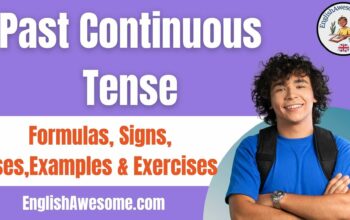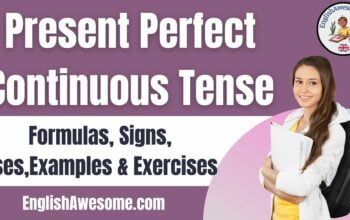Present Simple tense or Simple Present is one of the major verb tenses in English. Belonging to the present tense, simple tense, as the name suggests, is often known to be the easiest tense to understand and is usually used as the first step for English learners.
⏩ Sign Up to Get Bonus
In this article, we will talk about the basics of the simple present tense such as its definition, how to use it, why we use it, when to use it and how to identify it. Let's begin with English tivi right now.
What is Present Simple Tense?
Present Simple Tense Definition: A tense that is used to describe an obvious truth, an event that is happening right now, or something that happens regularly at the present.
When Should I Use The Present Simple Tense?
When talking about present simple tense usages, there are usually five different ways to use this tense:
To talk about a truth that is proven.
Examples:
– Earth has 7 continents.
– Sloth is the slowest animal in the world.
– JK. Rowling is a writer.
To talk about a fact that is currently true.
Examples:
– Jonathan is a college student.
– My family lives in New Jersey.
– My grandma is 90 years old.
To describe something that happen regularly.
Examples:
– I walk to school every day.
– My town has a carnival every summer.
– Linda usually drinks tea.
To talk about an event that is going to happen at a specific time.
Examples:
– The race begins at 8 a.m tomorrow.
– The dinner starts at 7 p.m.
– The bus leaves the station at 5 a.m.
To state an opinion or to describe an emotion.
Examples:
– Mary doesn’t like the carrot cakes.
– Joanna loves the balloons.
– Tommy is very excited.
The Present Simple Tense Formula
Present Simple Rules
Like other tenses, there usually are two types of subjects that can be used in the present simple tense: The I/You/We/They or the third person – He, She, It. Depending on the subjects the verb in the sentences that use a verb and the to be in a to be sentences will be changed.
We will talk about detail in Present simple Positive Sentences and Present simple Negative Sentences.

Present Simple Affirmative Sentences
- To be sentences:
| S + to be (am/is/are) + N/Adj |
With:
| S means Subjects | N means Noun | Adj means Adjectives |
How to use tobe:
| I | You/We/They | He/She/It | |
| To be | am | are | is |
Examples:
– I am an engineer. (I am can be shortened into I’m)
– They are fans of Star Wars.
– She is the CEO of this company.
- Sentences using verb:
| S + V(s/es) + N/Adj |
With:
| S means Subjects | V means Verb | N means Noun | Adj means Adjectives |
How to use different kinds of verbs:
| I/You/We/They | He/She/It | |
| Verb | The verb stays infinitive means the verb remains the same (V = V) | The Verb will have s or es or turn into a different form at the end depending on the verb we are using. |
Examples:
– We have to go to school every day.
– He plays piano.
– It cooks the rice pretty well.
Present Simple Negatives Sentences
- To be sentences:
| S + to be (am/is/are) + not + N/Adj. |
The change in tobe:
| I | You/We/They | He/She/It | |
| To be | am not | are not = aren’t | is not = isn’t |
Examples:
– I’m not a good teacher.
– You aren’t David.
– He isn’t the guy we are looking for.
- Sentences using verb:
| S + don’t/doesn’t + V(infinitive) + N/Adj. |
When to use don’t and doesn’t:
| I/You/We/They | He/She/It |
| don’t | doesn’t |
Examples:
– We don’t like rain.
– She doesn’t like the smell.
– He doesn’t work at a hospital.
Notes: don’t and doesn’t also depend on the amount that we talking about.
Examples:
– Dogs don’t know how to climb trees.
– My dog doesn’t know how to climb trees.
Present Simple Interrogative Sentences
Present Simple Yes/No Questions
- Tobe Yes/No question:
| Tobe (Is/Are/Am) + (Not) + S + (N/Adj)? |
Answer:
| (+) Yes, S + Tobe(Is/Are/Am) + N/Adj |
| (-) No, S + Tobe(Isn’t/Aren’t/Am not) + (N/Adj) |
Examples:
+ Are they factory workers? -> Yes, they are/ No, they aren’t.
+ Is he angry at her? -> Yes, he is/ No, he isn’t.
+ Isn’t it from 1990? -> Yes, it is/ No, it isn’t
- Yes/No question with verb:
| Do/Does + (Not) + S + V(infinitive) + N/Adj? |
Answer:
| (+) Yes, S + do/does |
| (-) No, S + don’t/doesn’t |
Examples:
+ Do you know how to get to Tony’s house? -> Yes, I do/ No, I don’t.
+ Doesn’t Linda like to go to the park? -> Yes, she does/ No, she doesn’t
+ Does Mike fix the car? -> Yes, he does/ No he doesn’t.
Present Simple Wh Questions
- Tobe Wh_ question:
| Wh_ + tobe (Is/Are/Am) + (Not) + S + N/Adj/…? |
Answer:
| (+) S + Tobe(Is/Are/Am) + N/Adj |
| (-) S + Tobe(Isn’t/Aren’t/Am not) + (N/Adj) |
Examples:
+ What is this book's condition? -> The book is damaged..
+ Where are they now? -> They are at school.
+ Who isn’t from this company -> Tony isn’t from this company.
- Wh_question with verb:
| Wh_ + do/does + (Not) + S + V(infinitive) + N/Adj/…? |
Answer:
| (+) S + V(s/es) + (N/Adj) |
| (-) S + don’t/doesn’t + V(infinitive) + (N/Adj) |
Examples:
+ What do you mean? -> I mean I like to go to the beach more than the mountain.
+ Why doesn’t May come to my class? -> Because she doesn’t come to school today.
+ When does he leave the house? -> He leaves in the morning.
Special Notes about the Present Simple Verbs
Like we mentioned above, depending on the subject the verb will change, and in sentences using verb positive form, the third person subjects will change the verb with s or es as the last word or in some cases as a different form. The verb change has its own rule that we have to follow:
- If the verb ends with ch, sh, x, ss, o or zz, we add es to the verb. The rest except “y” we add s to the end.
Example:
+ wash -> washes
+ watch -> watches
+ join -> joins
+ love -> loves
- if the verbs ends with “y” then we add:
es: if before “y: is a consonant.
Example:
+ study -> studies
+ party -> parties
s: if before “y” is a vowel (u, e, o, a, i)
Example:
+ play -> plays
+ employ -> employs
+ slay -> slays
- Special case: have will turn to has
Signal words for the Present Simple Tense
There are usually two types of signals that you can easily recognize in Present Simple Tense:
- The frequency adverbs: Always, usually, often, sometimes, occasionally, seldom, rarely and never.
Examples:
+ Mike always wakes up at 7 a.m.
+ Jane sometimes has breakfast at a restaurant.
+ I often go to the arcade after school.
- Words that are preferred to a cycle at times or the number of times an event happens during a period:
+ every day, every morning, every month, every year,…
+ once a week, three times a year,…
Examples:
+ My family goes to a fast-food restaurant once a week.
+ Tinna feeds the bird every morning.
+ Mrs. Summer comes to the cemetery once a year.
Present Simple Tense Exercises with Answers
Exercise of Present Simple Tense
Exercise 1: Fill the blanks with the correct form.
1. I ___(tobe) an student of this school.
2. Jane ____(love) to use the bike.
3. They ____(take) the car to come to the restaurant.
4. Why ____(do) he play it so good?
5. Who ___(tobe) the girl over there?
6. The oven ____(not/work) anymore.
7. Michael rearly _____(clean) his room.
8. Jamie ____(go) to work by bus once a week.
9. I ___(eat) at a restaurant three times a month.
10. Rose ____(have) a beautiful tent beside the beach.
Exercise 2: Rearrange the words to create the correct sentences.
1. work/here/Does/she?
2. do/I/plan/the/not/like/.
3. library/Do/know/you/to/how/the/get/to?
4. lunch/prepares/Jane/kids/for/her/the/morning/in/.
5. his/boat/lake/Tom/takes/sometimes/the/to/.
6. Pam/Does/the/news/knows/about/?
7. India/?/Are/from/they
8. wonderful/Kyle/a/has/robot/play/with/to/.
9. Las Vegas/family/goes/every/winter/to/My/.
10. do/you/to/want/go/Where/?
Answers of Present Simple Tense
Exercise 1:
| 1) am | 2) loves | 3) take | 4) does | 5) is |
| 6) doesn’t work | 7) cleans | 8) goes | 9) eat | 10) has |
Exercise 2:
1. Does she work here?
2. I do not like the plan.
3. Do you know how to get to the library?
4. Jane prepares lunch for her kids in the morning.
5. Tom sometimes takes his boat to the lake.
6. Does Pam know about the news?
7. Are they from India?
8. Kyle has a wonderful robot to play with.
9. My family goes to Las Vegas every winter.
10. Where do you want to go?
Present Simple Tense Exercises Pdf, Doc
This is a Pdf, Doc document that has some exercises for the present simple tense. It is a good idea to do these exercises to help improve your skills in the simple present tense.
Conclusion
Despite being the first tense that we usually use, Present Simple Tense should not be overlooked as it's the foundation of many other tenses. Anyone who learns English should try their best to understand most of this tense because the Simple Present plays an important role in this language.
Subscribe to the English tivi channel on Youtube to improve your English skills!





